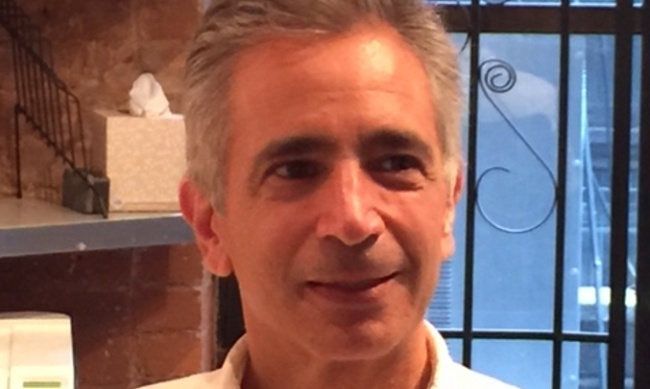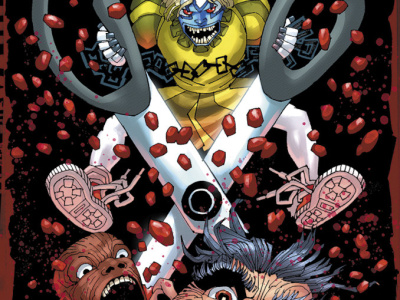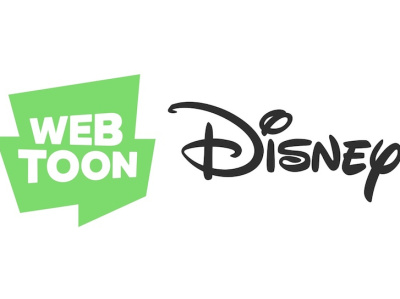One year after our interview with former Marvel COO Bill Jemas about his plans to launch a new line of comics for Double Take, the comic imprint of Take Two Interactive (Grand Theft Auto, Bioshock), we sat down for a conversation between Jemas and ICv2 CEO Milton Griepp. In Part 1, we talk about Jemas’ experience launching Double Take (hint: launching a new comic company is hard!), the company’s storytelling and its association with writers from The Moth, and the company’s decisions on how mature to make its books, and on how to package them. In Part 2, we talk about the company’s $9.99 graphic novel program, Jemas’ startling departure on overprints, comic pricing and how we got here, the quest for new comic customers, and the next steps for Double Take.
Tell us a little bit about the strategy for your first graphic novels, both in terms of positioning (are you looking for a different audience from the individual issues), and the low $9.99 introductory price for the first volumes.
What I’m about to say I absolutely believe, and if I didn’t believe this I would just go home. And you’ve seen me go home before, so what I believe is true is that if people read the graphic novels they’re going to enjoy them and they’re going to want to read all of them and they’re going to want to go to the comic book shops and spend a lot of money to get back issues of the 1, 2, 3, 4, and 5 for their collections. So our point of view is we want to use the graphic novels to reach new readers any way we can. I think the best way to do that is to keep the price point really low.
The goal is to reach new readers. The way to get there is to get 75% off to get retailers to take a shot with us. It’s also the price point, these are $10.00 books. We wanted to make it as easy as possible to buy one, so it’s not the $15.99 or $19.99, it’s just $10.00. And giving the retailers the really healthy discount because we want to make it worth their while to give it a shot with us. And in addition to that we printed thousands and thousands of #1, 2, 3. If you remember #1, 2,3s, there was a time at Marvel when we would sell out of our hottest books, and we’d refuse to reprint the #1s, so you couldn’t get Ultimate Spider-Man #1, it just wasn’t available. So between the time of the #1 being printed and the graphic novel coming out, we took the first three issues of Ultimate Spider-Man and bundled it into one soft cover and sold that for some inexpensive amount like $2.99. People bought them like crazy and we primed the pump for the retail market for graphic novels.
So what we decided to do, since we don’t have that existing rabid Spider-Man base is we printed a lot of #1, 2, 3, collections of our three most popular books, Z-Men, Dedication, and Remote. We’re just going to give five free copies to every retailer who’s on our customer list now, and a couple more people who are not, in the hopes that they’ll just hand those out to customers for free and prime the pump for the graphic novel business. I really do believe that if people buy our books, they’re going to like them and read them, if I didn’t believe that I shouldn’t be here. We’re putting our money and time and effort where our hearts are. Low price point, lots of sampling, and a really good point for readers to jump on board without a lot of risk.
What are you doing in the book channel?
Bookmasters is our book distributor. They’re out there pitching to Barnes & Noble and the indie booksellers. They may not get the identical offer a comic book shop will get because my sense is that those guys don’t have the handselling opportunity or skill set necessarily (some of the indies do, but not all of them, and certainly not for graphic novels), so we think we may want to do a deal that’s adjusted so they can get posters or shelf-talkers or even a free-standing display for getting behind us. So our sense is from Gabe Yokum talking to all the comic retailers that will talk to him, that dollars off for the comic retailers is the best thing, we’re not so sure that deep discounting is as good for a bookstore guy as a POS would be.
You’ve reversed your strategy from Marvel in terms of overprints on initial comics, how did that work out for you?
We went a little bit long on the issue #1s. We’re mostly done with them , but we’re holding some back on the theory that when the graphic novels hit, that there will be an appetite for people who want to own a #1. There are some #1 Super Packs; there are no individual #1s but there are some Super Packs in inventory and we’re kind of using them for promotions and bonuses. So if a retailer wants to run an in-store event we’ll get them a pack of #1s as a gift, or a customer winning a costume thing, or gift with purchase. So by and large we’re happy we did that, obviously we only did that for the #1s so we’re relatively comfortable.
There is this overall difficulty being small in that in that you want to give customers a good, solid, fair price, and if your print runs are too low then you end up spending so much money that you can’t offer a good, solid, fair price. And one of the things that’s hurting the industry is overpriced comics. So we still do print a little bit more than we need, and that gets us a good price from the printers, and then we try to give away the books more than sell them. Because I don’t know that it’s fair to a retailer that takes a position with us that we’re going over them and selling. So for the most part we try to use the overprints for promotions.
We did a Throwback Thursday recently to note the month that The Killing Joke was released (see "Throwback Thursday: When ‘Killing Joke’ Was New"). One of the things that we looked at was the price, and comics in 1988 were a buck, and if you do the inflation calculator, now they should be two bucks. But they’re four bucks.
Everybody knows that comics are too expensive in terms of trying to get readership. If you’re building a business and trying to build readership, objectively comics are out-priced compared to other entertainment choices. Why do you think the pricing is so high across the industry?
I think it’s been a spiral since that era, and it’s related to the growth of the comic shop and the decline of mass market distribution. There was declining circulation, publishers would raise prices to try to preserve their margins and their viability, that would further reduce the ability to sample new customers, distribution was constricting at the same time in terms of the number of outlets, so we got to where we are today, which is fewer customers buying through fewer outlets at higher prices. And how do you get back from that? Somebody’s got to make a big bet to go back from that.
When I met you, it was one of those "Gee, here’s the smartest guy in the room" moments. I had just started at Marvel and I was running their Fleer trading card business. I knew you a little bit because you took a decent position with the Marvel cards. I was at a Marvel summit with you and retailers were going after Marvel’s mass market guys, not with a meat cleaver, but with some legitimate and illegitimate complaints, encouraging Marvel to either kill off or cut back newsstand.
At the time, I think Marvel was in at least 50,000 newsstand outlets, maybe even more.
What year was this?
Let’s say this was 1993. And there were a lot of retailers, and you were a distributor, but you kind of stood up to the retailers and said "Listen guys, we need new customers." You weren’t saying that the newsstand was perfect or that we didn’t need to fix some of our policies, but you said, "If you lose that feeder system, you may be happy in the short term, but in the long term your businesses will become less and less viable because you don’t have that impulse purchase where the kid goes to the rack, thumbs through 30 comics, ruins them, but gets the inclination and gets the habit." What you said turned out to be very true. With the loss of the mass market, you can feel the loss of new customers.
Yeah, but the problem was that system was corrupt and inefficient.
Yeah, yeah.
So it was not viable in its current form, and in fact, if you look at magazine distribution today it’s almost gone; it’s down to like one company.
One of the first things I did when I took over Marvel was I put newsstand on a moratorium until we could figure out how to keep the bastards from making believe they were returning comics and selling them to comic shops.
Keep the theft at a reasonable level, right?
Exactly. We knew they were going to steal, but we wanted to calculate the steal and work it into the margins. I agree that the system was so corrupt and damaging. But wow, you have to substitute with something.
I have a question. Is there a way out of the pricing spiral?
Graphic novels are not terribly priced relative to other forms of print entertainment, so the book format has become a new feeder system because there are a lot more customers that shop at places where graphic novels are sold than shop at where periodical comics are sold, and that attracts new customers that don’t see comics any other way. So that’s been one really positive development in the last 15 years.
I had hoped, and still hope that digital could perform some of that function, and I think the ultimate answer to that remains to be seen. Some of the bundles have gotten prices really low, but I’m not sure they’re overall good for the market. I think they’re hitting the most rabid fans who want huge quantities and maybe just reduce their overall catalogue purchases later. But we need more experimentation, more different ways to approach the market digitally, because that is the ultimate reach. Everybody’s got a phone in their pocket, and everybody can read a comic on their phone, so I hope we can find more ways to use digital delivery to expand the market.
I want to bring you in to meet with my boss because what you’re saying now is what I’m hoping to be true and it’s the basis of our business plan, which is to use graphic novels with a low price point as a for the individual comics, and then also use our mobile player. As we discussed in the last interview, we developed the first native mobile comic player, and are doing our comics one panel at a time so you can read them with a cell phone, and even got lucky. The part that wasn’t planned was that we discovered that we could more or less stop-motion animate the comics. As you’re flipping pages, the characters come to life. So we’re thinking the same way. I’m hoping that you’re right and this all works.
The only other possible conclusion if you look at the overall circumstances is that the culture has shifted and that comics are no longer as viable a medium as they were 30 years ago, and I have a hard time believing that’s true, because people that get exposed to them love them, and tell their friends about them, and grow in their readership. So I do believe that it’s a matter of exposure and trying to create an awareness that there’s not just movies based on comic characters, there’s actually a lot of great original work being done.
Also, on your cheap graphic novels, obviously Image has used that strategy very successfully and they’ve got scale now but they have a similar problem in the sense that their properties are almost all unknown, so when they launch a new product, like Bitch Planet, they’ve got to figure out a way to get people to try it, not only in comic stores, but in bookstores, and they do that with these $9.99 books and I think that’s a really good strategy.
What are you going to do after this? Do you have another arc planned, and if so when are you going to start it and what’s it going to be?
We’ve been doing binge-reading ten-packs, and we’re getting worn out. It takes a lot longer to do ten than I thought it was going to be. With a handful of people writing the plots we have to shift from book to book and it’s difficult. In the future, we’re going to finish this ten, and then we’re going to focus on just five series at a time. And those series will be dominated by superheroes.
It’s very hard in a vacuum to get how long it will take us to get the next series of books started, but we‘re going to finish this creative in August, we should be finished with the next round of creative in October. So toward the beginning of next year, we’re going to continue two or three of these current series and launch three new ones, and we’re just going to focus on five series at a time. Ideally we’ll be monthly at that point. If we get good at it we may be able to do a little bit better than monthly. As you’ll recall back at Marvel we were shipping Ultimate Spider-Man twice a month, some of the other books once every month and a half. So we’re going to narrow down to fewer books and get more of them out on a regular basis.
There’s a trade-off. The fans that like the ten-packs really like binging on them ten at a time; our guess is that they’re going to like binging on five at a time. And the retailers would rather sell something with a lower price point so the $20 price for a Super Pack will go down to $10 for a five-pack. That’s the direction that we’re going.
Click here to go back to Part 1.

'Everybody Knows Comics Are Too Expensive'
Posted by ICv2 on June 30, 2016 @ 2:58 am CT
MORE COMICS
From Image Comics
August 14, 2025
The Curse of Sherlee Johnson #3 debuts two iconic new variant covers from Frank Miller and Todd McFarlane, on shelves this September from Image Comics.
To Bring Marvel, Star Wars, Disney, and 20th Century Studios Comics to Webtoon Platform
August 13, 2025
The deal will bring comics from the Disney, Marvel Comics, Star Wars, and 20th Century Studios brands to the Webtoon platform.
MORE NEWS
Pairing Neo-Gotham's Batman with Dakota City's Static
August 13, 2025
The series teams up Terry McGinnis, the Batman of Neo-Gotham, and Virgil Hawkins, Milestone’s Static.
For 'Cosmere Roleplaying Game'
August 13, 2025
Brotherwise Games will be launching the Cosmere Roleplaying Game: Stormlight series.








